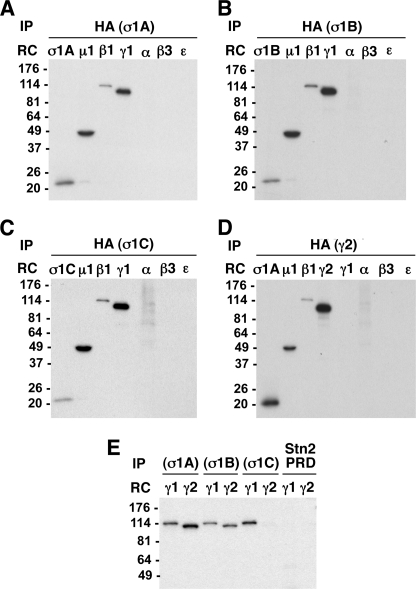FIGURE 8.
In vivo assembly of multiple AP-1 complexes containing different γ or σ1 subunit isoforms. A–D, M1 human fibroblasts were stably transfected with vectors driving the expression of σ1A-HA, σ1B-HA, σ1C-HA, or HA-γ2. Cells were metabolically labeled for 12–15 h with [35S]methionine and [35S]cysteine. Cell lysates were subjected to immunoprecipitation (IP) with anti-HA, and the immunoprecipitates were denatured, diluted, and subjected to additional rounds of immunoprecipitation (RC, recapture) using antibodies against the HA epitope, or μ1, β1, γ1, α, β3, or ϵ subunits (A–C) or σ1A, μ1, β1, HA, γ1, α, β3, or ϵ subunits (D). The recaptured immunoprecipitates were subjected to SDS-PAGE and fluorography. The analysis demonstrates that σ1A, σ1B, and σ1C subunits are all incorporated into AP-1 complexes also containing μ1, β1, and γ1 subunits, but not into AP-2, AP-3, or AP-4 (lack of recapture of σ1A, σ1B, or σ1C by either anti-α, -β3, or -ϵ) (A–C). The γ2 subunit also assembles into AP-1 but not AP-2, AP-3, or AP-4 (D). E, M1 cells stably transfected with HA-γ2 were subjected to transient transfection with vectors driving expression of σ1A-Myc, σ1B-Myc, or σ1C-Myc (a Myc-tagged stonin 2 proline-rich domain (Stn2 PRD) was used as a negative control). Transfected cells were metabolically labeled and lysed, followed by immunoprecipitation with anti-Myc and recapture with either anti-γ1 or anti-HA (for detection of γ2). Note that γ1 is incorporated into AP-1 complexes containing any of the three isoforms of σ1, whereas γ2 can only assemble into AP-1 complexes containing either σ1A or σ1B.

